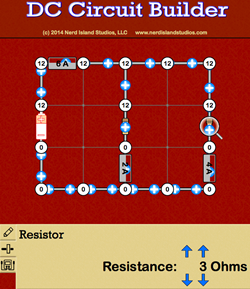 Series and Parallel Circuits
Series and Parallel Circuits
Resource:
Physics Interactives: DC CIrcuit Builder
Student Exerice: Series Circuits
Student Exercise: Parallel Circuits
Grade Level: High School
Description:
This set of activities is designed to promote deep understanding of series and parallel circuits through modeling and guided exploration of mathematical relationships. The DC Circuit Builder allows students to add resistors, bulbs, wire, and batteries. You can also change the battery voltage or the amount of resistance and watch the effects on the current flow and light bulb. The companion student exercises take the learning up a notch for high school physics courses – they challenge students to do the following tasks: 1) Use mathematics to calculate values for change in voltage, current, and resistance; 2) Rewrite equations to highlight specific variables of interest; 3) Apply their knowledge to show the validity of an equation as it relates to circuit analysis.
Performance Expectation:
HS-PS3-1: Create a computational model to calculate the change in the energy of one component in a system when the change in energy of the other component(s) and the energy flows in and out of the system are known.
This activity aligns with the three dimensions of the Next Generation Science Standards in the manner described below:
| Definitions of Energy (HS-PS3.A.4): “Electrical energy” may mean energy stored in a battery or energy transmitted by electric currents. |
As a whole, this activity provides a low-stress environment for students to build virtual circuits, use virtual ammeters and voltmeters, and analyze the math of series and parallel circuits. The simulation explicitly addresses the NGSS Core Idea that defines electrical energy as energy transmitted by electric currents. |
| Structure and Function: Investigating or designing new systems or structures requires a detailed examination of the properties of different materials, the structures of different components, and connections of components to reveal its function. |
Circuit simulators provide a very engaging way for students to explore a system. The DC Circuit Model explicitly addresses “Structure and Function” and “System Models” as students pay attention to how circuit components can be connected to produce the differing features of a series vs. a parallel circuit. |
| Cause and Effect: Systems can be designed to cause a desired effect. |
This activity prompts students to think of “Cause and Effect” relationships in their circuit design. For example, “If I increase/decrease the voltage, what effect does this have on light intensity from the bulb or current at a given location in the circuit?” |
| Using Mathematics and Computational Thinking: Use mathematical representations of phenomena to describe explanations. |
In the DC simulator with accompanying Series and Parallel Student Exercises, students use mathematics in completing tables that show values for electric potential difference, current, and resistance. They use the results of their computations to draw general conclusions regarding he relationships between various quantities in series and parallel circuits. |
Associated Reading from The Physics Classroom
Other Supporting Pages at The Physics Classroom:
View Infographic.
(Coming Soon)
Search the NGSS Corner
Maybe you're looking for something really specific that pertains to a desired topic and emphasizes one or more of the listed NGSS dimensions. Why not try a search of this section of our website? Simply select from one or more of the pull-down menus and click Search This page will reload and a collection of possibilities will be displayed in this section of the page and sorted by relevancy.